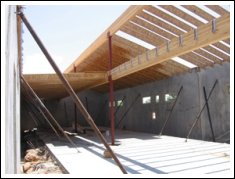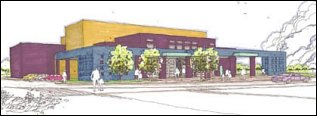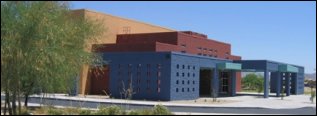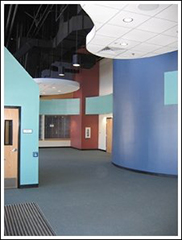| Healthy - Good indoor air quality is essential. The time students and teachers spend inside schools, combined with children's vulnerability to indoor pollutants, underscores the importance of high indoor environmental quality. A properly designed heating, ventilating, and air-conditioning (HVAC) system minimizes the intake and circulation of pollutants by providing air filtration, ventilation, and air changes. Reducing chemicals in maintenance products, implementing Integrated Pest Management, and proper training of maintenance and operations staff help assure an environment with less toxic chemicals.
Energy Efficient - Energy efficient schools save money while conserving non-renewable energy resources and reducing air pollution. HVAC systems use high efficiency equipment, are "right-sized" for the estimated demands of the facility, and include controls that optimize system performance. The school's lighting system uses high-efficiency products, optimizes the number of light fixtures in each room, incorporates control devices that ensure peak system performance, and successfully integrates electric lighting and day-lighting strategies. The walls, floors, roofs, and windows of a high-performance school are energy efficient and cost effective. The building shell integrates and optimizes insulation levels, glazing, shading, thermal mass, air leakage, and light-colored exterior surfaces to minimize energy consumption.
Materials Efficient - Where possible, the school conserves raw materials and minimizes energy consumed for transportation by incorporating local and regional building materials. Such materials may be manufactured with a rapidly renewable resource or recycled content, are durable, and/or can be recycled or reused. In addition, the school is designed and built in a manner that it reduces waste and keeps useful materials out of landfills.
Water Efficient - High-performance schools are designed to use water efficiently, saving money while reducing the depletion of aquifers and river systems. The school uses as little offsite water as possible to meet its irrigation needs, controls and reduces water runoff from its site, and consumes fresh, clean water from public sources as efficiently as possible.
Easy to Maintain and Operate - Building maintenance and operations consider all systems as a whole, working interactively instead of as individual systems. These systems include heating and air conditioning, plumbing, indoor air quality, and lighting. Also included is ecosystem protection and materials efficiency, the using of resources in a manner to conserve raw materials and reduce wastes, thereby minimizing impacts on the environment. Maintenance staff is trained to assure the school maintains its high performance operating standards. Teachers also are trained to effectively use the building systems.
Environmentally Responsive - The site is recognized as an essential element of the school building's high performance features. To the extent possible, the site conserves existing natural areas and restores damaged ones, minimizes stormwater runoff and controls erosion, and incorporates products and techniques that do not introduce pollutants or degradation to the project site, or to the site of extraction, harvest or production.
Reduced Operating Costs - Using life-cycle cost methods, green schools are designed to minimize the long-term costs of facility ownership. By using less energy and water than standard schools, overall operating costs are lower.
Improved Health of Children and Teachers - Green schools provide superior indoor air quality by controlling sources of contaminants, providing adequate ventilation, and preventing moisture accumulation.
Some evidence shows that high performance schools can lead to increased average daily attendance and increased teacher satisfaction and retention. A growing number of studies are confirming that facilities with appropriate acoustics, lighting, indoor air quality, and other high performance features enhance learning and contribute to higher test scores.

|

Davidson Elementary School, currently under construction in Tucson |
| List of Green Educational Facilities in Arizona
 
Desert Edge High School, Goodyear, from design to reality
Green schools are becoming a reality in Arizona. School districts that are going green with one or more schools include: Agua Fria Union High School District, Bullhead City Elementary School District, the Hopi Tribe Office of Education and Tucson Unified School District. Charter schools are also building green; one intending to be green is Mohave Accelerated Learning Center in Bullhead City. Community Colleges are building green, too. The Chino Valley Agribusiness and Science Technology Center, Yavapai College and the Plaza Building, Desert Vista Campus, Pima Community College are LEED certified buildings. Besides schools, other teaching venues are going green, places such as the Highlands Center for Natural History in Prescott plus special classroom designs like at Tucson Reid Park Zoo.
|

Desert Edge High School, Goodyear |